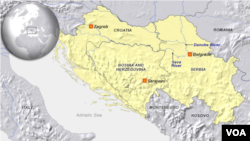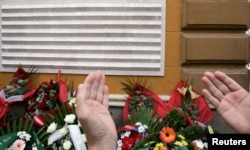The Ministry of Justice in Republika Srpska, the Bosnian Serb entity of Bosnia-Herzegovina, is planning to stage what it calls a "reconstruction" of two tragic episodes of Bosnia's 1992-95 war that furthered the international isolation of Serbian forces at the time and spurred Western resolve to intervene militarily.
Officials in Banja Luka say the effort is part of an investigation aimed at establishing "the truth" about who fired the shells that killed 111 people and wounded 219 more in two separate bombardments of Sarajevo's Markale market in 1994 and 1995.
Critics, however, accuse the Bosnian Serb authorities of trying to whitewash terrible wartime crimes and justify other atrocities at the expense of "digging into the wounds" of the families of victims.
The event will not be staged at the scene of the massacres, in the Bosnian capital, or even in Bosnia.
Reenactment approved
RFE/RL's Balkan Service reported the Defense Ministry in Belgrade has given its approval for Bosnia's predominantly ethnic Serbian ministate to carry out its plans on Serbia's territory, at the village of Vojvodina Nikinci.
Milorad Kojic, the head of the Republika Srpska Justice Ministry's Center for Research on War, War Crimes, and Missing Persons in Banja Luka, told RFE/RL that the activity will be reviewed by a panel of "international experts" -- including experts from the United States.
Kojic would not identify the experts involved nor reveal exactly when the "reconstruction of the crime" would be carried out.
"An investigation will be conducted based on documents that show how it really happened, and, in this way, the scene will be set up in an authentic way," Kojic said. "The shells will go off and then the investigation will take place."
It was a single 120-millimeter mortar shell fired into Sarajevo's historic city center on February 5, 1994, that killed 68 people and wounded 144.
Eighteen months later, on August 28, 1995, five shells fired into Markale market killed 43 people and wounded 75.
With television crews from around the world already positioned in Sarajevo at the time of both bombardments, the massacres focused international attention on the toll Bosnia's war was taking on civilians.
In fact, the August 28 attack was the reason given by NATO for launching air strikes against Bosnian Serb forces -- an international military intervention that changed the course of Bosnia's war, eventually leading to the defeat of the Bosnian Serbs and the signing of the Dayton peace accords.
Hague convictions
Based on evidence compiled by United Nations monitors, The Hague-based International Criminal Tribunal for the former Yugoslavia (ICTY) ruled in 2003 during the trial of Bosnian Serb commander Stanislav Galic that his forces were responsible for both attacks on Markale market.
Galic was sentenced to life imprisonment for crimes against humanity over his role in the siege and shelling of Sarajevo.
Although the first international investigators to arrive at Markale market after the February shelling told RFE/RL that the projectile clearly came from Bosnian Serb-controlled territory, later reports by international investigators did not lead to unambiguous conclusions.
Belgrade state-run television, along with Bosnian Serb leaders at the time, immediately pinned the blame on Bosnian Muslim forces -- spreading the narrative that Bosnian Muslim troops targeted their own people at the market in order to provoke Western intervention on their side.
Bosnian Serb leader Radovan Karadzic tried to use the claims of Bosnian Muslim responsibility for the market shellings during his defense against war crimes charges, but his attempt was rejected by the ICTY.
In March 2016, the ICTY found Karadzic guilty of genocide, war crimes, and crimes against humanity -- including responsibility for the Srebrenica massacre in which around 8,000 Muslim men and boys were massacred in a corner of what is now Republika Srpska -- and sentenced him to 40 years in prison.
'Digging into the wounds'
Kojic told RFE/RL that the "the primary objective" of staging a "reconstruction of the crime" was "to show the truth, because it is these events that burden the Serbian people and show a distorted picture of the nature of the war."
Kojic also suggested that the material produced by his office in Banja Luka "can be made accessible to the defense teams" in war crimes cases and used as "new facts and proof" in order to launch new proceedings.
But Senida Karovic, head of the Sarajevo-based Union for Civil Victims of War, told RFE/RL the effort was an attempt by the Bosnian Serb authorities to deny the crimes committed by Bosnian Serb forces during the war.
"This is a provocation, and it is digging into the wounds of the victims after 20 some years," Karovic said. "I think that behind this action are bad intentions on the part of the Serbian leadership and denial of what they did."
Karovic added, "It may be that they are trying to justify the crimes committed by their compatriots."
Berko Zecevic, an expert witness who testified in connection with the Markale shellings, said Banja Luka's new initiative was founded in politics, not science or even the pursuit of truth.
Denying guilt?
Zecevic said any doubts about the conclusions of the ICTY and international investigators were ridiculous.
"Essentially there are some differences," Zecevic told RFE/RL, "but it does not play a role" in altering the conclusion that Bosnian Serb forces were responsible.
Natasha Kanic, a coordinator in an effort to create a regional truth-seeking commission called REKOM for the former Yugoslavia, accused Belgrade of sending a negative message to neighboring countries and international institutions by allowing the Bosnian Serbs to stage the event in Serbia.
"It's a message that says a lot about what Serbia thinks of the international institutions -- I mean the International Criminal Court and the International Court of Justice, [and the ICTY]," Kanic told RFE/RL.
"The fact is that Serbia is siding with those who say that everything proven at The Hague -- and this implies the crimes committed by the Bosnian Serb Army -- is not true," Kanic said.
Belgrade's Defense Ministry would not comment on its decision to allow the event to be staged in Serbia.
But Kojic defended the idea of trying to recreate the Markale shellings outside of Bosnia. "It is impossible to do the reconstruction at the authentic locations, because the places look differently than they did in the 1990s," he said.
"The place is not the same anymore, so how can any investigation take place [in Sarajevo]," he said. "On the other hand, the scene will be portrayed in an authentic way [in Vojvodina Nikinci] and a shell will be launched. In any case, it's not feasible to do this in the place where these events really did happen."
Dusan Komarcevic in Belgrade contributed to this report.








